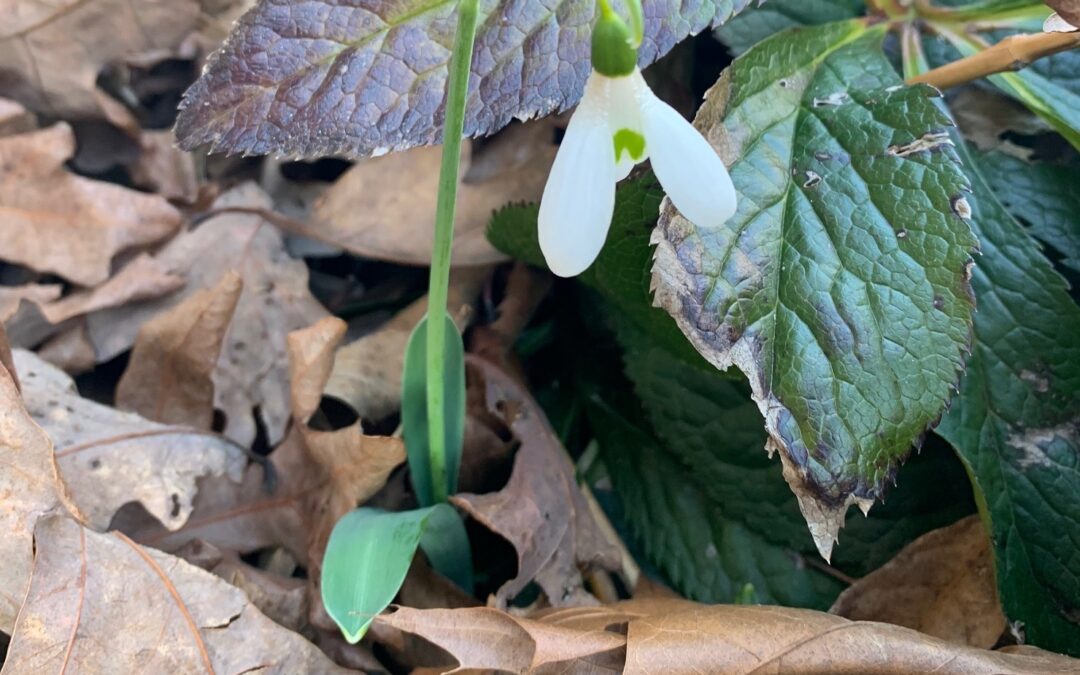Yesterday I was poking around my garden here in West Virginia and found that the daffodils and tulips were already above ground by several inches. The little white snowdrops are blooming already in my daughter’s garden. How can they endure the nighttime temperatures well below freezing?
Snowdrops, like crocuses, will even grow through the snow. Just last week we had about 3 inches of snow everywhere and the temperature was 6 degrees Fahrenheit (-14 degrees Celsius) at night. Of course, the snow melted this week and our lovely days of sunshine probably encouraged the snowdrops to bloom.
Certainly this little white flower wants to be pollinated even though it is still cold. What kind of insects are able to function when it is this cold? Does this flower hope to be pollinated by the wind?
Apparently not. These little snowdrops are adapted to be buzz pollinated. A native bee, or sometimes a special fly will grab onto their anther and cause it to vibrate so fast that the anther releases its pollen onto the back of the bee. Bumble bees are adept at “buzz-milking,” but the honey bees that we have brought here from Europe cannot pollinate these little flowers, because they cannot sonicate or shake the anthers to release the pollen.*
I have not seen any bumblebees yet, so this little snowdrop must be expecting to stay alive and beautiful for quite awhile. It must wait until new bumblebees emerge from their underground homes and are looking for pollen. This will require that the earth warms up enough to encourage development of the bumblebees.
Snowdrops are classified by botanists in the family of Amaryllidaceae, the same family of flowers that includes the big lush red Amaryllis. Who would guess that the flowers that are so different in size and color would belong to the same family? Amaryllidaceae also includes all the narcissus and daffodils that create such beautiful early spring flowers. They will be blooming soon with just a little more warm weather.

Keeping the bulbs of daffodils and tulips vibrant is important to assuring that they will bloom every year. Daffodils in northern Wisconsin thrive year after year, because they are poisonous to moles, squirrels and deer, so animals do not feed on their bulbs during the winter.
When the flowers finish blooming, it is also important to allow their leaves to remain in the sun until they turn brown and die. The leaves produce sugar when the green chlorophyll in their leaves and the sun combine to create food for the plant. This is stored in the bulb to give it energy for spouting the next spring. If you mow down daffodil leaves before they have turned brown, they will not bloom the next year. They may not even have enough energy to grow new leaves.
The same is true of my large red amaryllis flowers. Not only do they store food in their own bulbs, they grow new bulbs during the summer when we keep them in pots on a sunny porch. The little snowdrops also make food in their leaves, though their leaves are dry by early summer when taller flowers and grass thrive, shading them entirely.
What do you have poking up through the soil in your garden? Did you plant it? Or did it just find its way there by some lucky chance?
*Wilmer, Pat, Pollination and Floral Ecology, Princeton University Press, 2011, p. 175.


